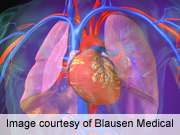A new definition of post-percutaneous coronary intervention bleeding and a new predictive risk model can better identify patients at risk for bleeding complications, according to a study published in the September issue of the Journal of the American College of Cardiology: Cardiovascular Interventions.
(HealthDay)—A new definition of post-percutaneous coronary intervention (PCI) bleeding and a new predictive risk model can better identify patients at risk for bleeding complications, according to a study published in the September issue of the Journal of the American College of Cardiology: Cardiovascular Interventions.
Sunil V. Rao, M.D., from the Duke Clinical Research Institute in Durham, N.C., and colleagues analyzed clinical data from the national CathPCI Registry from February 2008 through April 2011 to identify factors associated with major bleeding complications occurring within 72 hours post-PCI. Subgroup analysis included females; those older than 70 years of age, with diabetes mellitus and ST-segment elevation myocardial infarction; and those who did not undergo in-hospital coronary artery bypass grafting.
The researchers found that the bleeding rate was 5.8 percent when utilizing the new bleeding definition (site-reported arterial access site bleeding, which may be either external or a hematoma; retroperitoneal, gastrointestinal, or genitourinary bleeding; intracranial hemorrhage; cardiac tamponade; post-procedure hemoglobin decrease; or post-procedure non-bypass surgery-related blood transfusion). A newly developed full risk model included 31 variables and the risk score had 10 variables. There was similar discriminatory value across the subgroups using the full model, which was well calibrated across the PCI spectrum.
"Risk models that use this expanded definition provide accurate estimates of post-PCI bleeding risk, thereby better informing clinical decision making and facilitating risk-adjusted provider feedback to support quality improvement," the authors write.
Several authors disclosed financial ties to the pharmaceutical industry.
Copyright © 2013 HealthDay. All rights reserved.



















